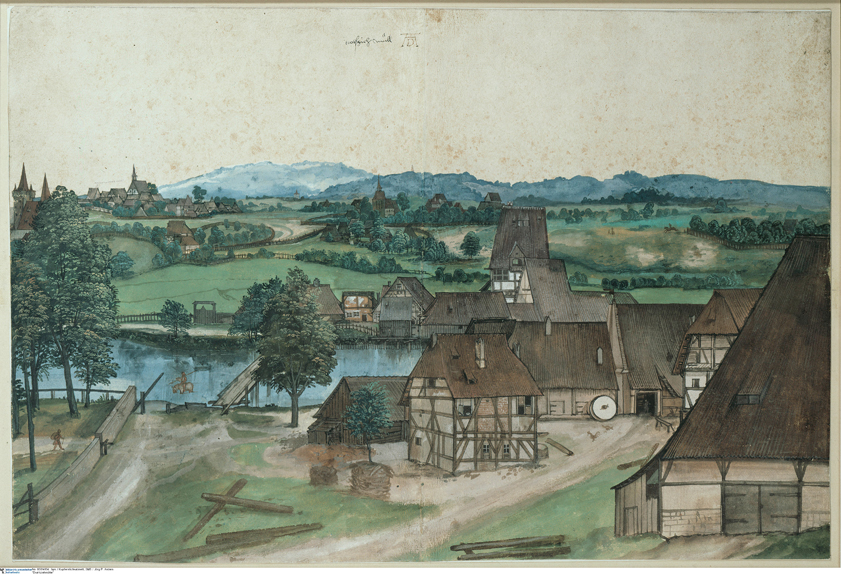The largest exhibition of the works of Dürer in 40 years
This summer, the German National Museum in Nürnberg hosts the largest exhibition with works by Albrecht Dürer in 40 years. The exhibition is built around five themes, focusing on his idea of himself as for instance witnessed in the development of the “first” copyright protection scheme, the influence from his neighbors in the formation of his persona and art plus his work as a dramatist an narrator, as is witnessed in his large production of early prints, as well as in his strive for technical perfection as a painter of natural objects and scenes of nature. A separate part of the exhibition showcases the way in which modern art historians tries to solve some of the puzzles through scientific methods of investigation.
The exhibition has been complicated to curate. One reason is that paintings and other artworks of Dürer are not easy to borrow from other museums. Several very important painting are shown, amongst those the “Kreuzabnahme”, which has undergone heavy restoration during the last years.
However, one particular painting, which was on the wish-list, was the self-portrait by Dürer, which hangs in München in the Alte Pinakothek, the so-called “Selbtsbildnis im Pelsrock”, will not be shown. This is the painting, where Dürer poses as Jesus, and which he later presented to the council of the city of Nürnberg in 1509 (it was later sold during the Napoleonic wars).
 Naturally Nürnberg tried to borrow the painting for the exhibition. “Nein” said München, and argued that the painting is not typical of “The Early Dürer” (although it was painted, when he was young). Accordingly München could not see a reason for the loan. Further it was indicated, that the Museum considered the painting central to the exhibition in München, since it draws huge crowds (and income). Finally, they claimed that the painting had been damaged the last time it had been lent to Nürnberg in 1971 and finally that it was too fragile. Naturally the curators in Nürnberg felt insulted by the insinuation that they were not good caretakers – actually a very damaging slander in so far as that might put a stop to other in-loans. Further, they felt entitled to borrow, since both museums actually belong to the same institution. After a lot of bickering both upfront and – we must presume – behind the scenes, and after the Landestag had voted to order München to lend the painting to Nürnberg, a joint committee of conservationists from both museums examined it. Their verdict was unanimous: The painting was too fragile to be transported. Further, the damage stemmed not from 1971, but was already visible in the 1930ies.
Naturally Nürnberg tried to borrow the painting for the exhibition. “Nein” said München, and argued that the painting is not typical of “The Early Dürer” (although it was painted, when he was young). Accordingly München could not see a reason for the loan. Further it was indicated, that the Museum considered the painting central to the exhibition in München, since it draws huge crowds (and income). Finally, they claimed that the painting had been damaged the last time it had been lent to Nürnberg in 1971 and finally that it was too fragile. Naturally the curators in Nürnberg felt insulted by the insinuation that they were not good caretakers – actually a very damaging slander in so far as that might put a stop to other in-loans. Further, they felt entitled to borrow, since both museums actually belong to the same institution. After a lot of bickering both upfront and – we must presume – behind the scenes, and after the Landestag had voted to order München to lend the painting to Nürnberg, a joint committee of conservationists from both museums examined it. Their verdict was unanimous: The painting was too fragile to be transported. Further, the damage stemmed not from 1971, but was already visible in the 1930ies.
The result: The painting stayed in München and the Alte Pinakothek may probably enjoy a deluge of visitors travelling from Nürnberg to München this summer. Before traveling there, visitors should take the time to see the Albrecht-Dürer-Haus, where the artist lived from 1509 -1524. The house still stands and visitors may get a feeling for the living conditions of an artist in the beginning of the 16th century. Further the museum hosts a workshop where it is possible to get acquainted with the painting techniques and materials at that time.
Der Frühe Dürer
Germanisches National Museum, Nürnberg
24.05.2012-02.09.2012
Das Albrecht-Dürer-Haus
Albrecht-Dürer-Straße
Nürnberg
Dürer: Das ferne Genie. Eine Biographie.
Thomas Schauerte.
Reclam, Ditzingen 2012
Read about the “Ausleih-Streit”, the controversy, between Nürnberg and München in Faz
